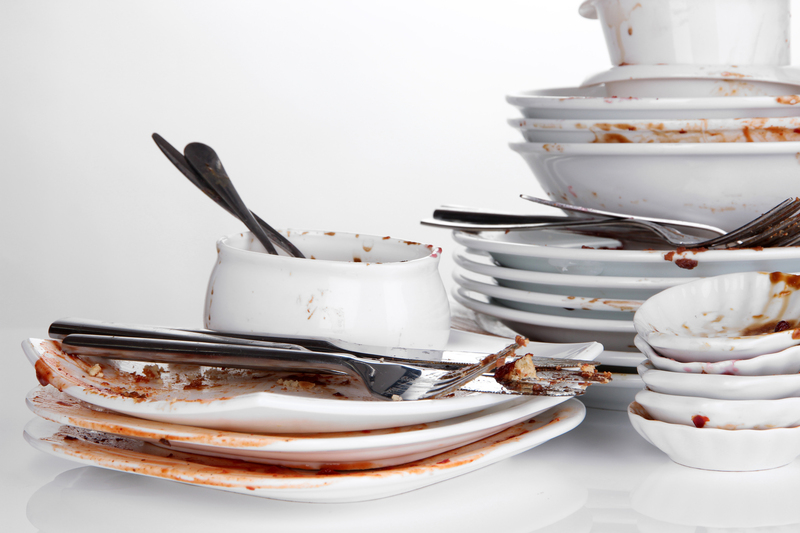Revitalize Your Stovetop: Effective Methods to Remove Burnt-on Residue
Posted on 23/08/2025
Revitalize Your Stovetop: Effective Methods to Remove Burnt-on Residue
Are you tired of staring at a burnt-on mess on your stovetop every time you cook? A sparkling clean stovetop is not just pleasing to the eye, but it also ensures hygienic meal preparation and helps prolong the lifespan of your kitchen appliance. If you're struggling with persistent grime, stubborn scorch marks, or caked-on food residue, don't worry! This comprehensive guide will help you revitalize your stovetop with effective methods to remove burnt-on residue regardless of the stove type you own.

Understanding Burnt-On Residue and Its Impact on Your Stovetop
Before diving into cleaning techniques, let's understand what causes burnt-on residue and how it affects your stovetop's efficiency.
- Food Spills: Boil-overs and splatters that aren't cleaned up immediately get baked onto the surface.
- High Heat: Excessive heat hardens spills, making them tougher to clean.
- Improper Cleaning: Using harsh abrasives or neglecting regular cleaning can diminish your stove's finish and performance.
- Bacterial Buildup: Old residue can harbor bacteria, impacting your kitchen's hygiene.
Regular care is vital. Over time, stubborn, burnt-on spots can become nearly impossible to remove and may even cause discoloration or permanent damage.
Determine Your Stovetop Type - Why It Matters
Not all stovetops are the same. Knowing your stove surface is crucial when choosing the most effective method to remove burnt-on residue without causing damage.
- Gas Stovetops: Typically have removable grates and burners. Surfaces are usually enameled or stainless steel.
- Electric Coil Stovetops: Feature exposed metal coils and drip pans beneath.
- Glass and Ceramic Cooktops: Have smooth, easy-to-wipe surfaces but are prone to scratching with abrasive tools.
- Induction Stovetops: Similar surface to glass or ceramic cooktops, requiring non-abrasive cleaning.
Effective Methods to Remove Burnt-on Residue From Any Stovetop
1. Basic Cleaning for Light Burnt-On Residue
For light to moderate burnt-on residue, a quick daily clean can prevent severe buildup.
- Let It Cool: Never attempt cleaning while your stovetop is hot.
- Remove Easy Debris: Use a soft damp cloth or paper towel to wipe away loose crumbs and splatters.
- Mild Soap Solution: Mix a few drops of dish soap with warm water. Using a non-abrasive sponge or microfiber cloth, gently wipe the surface, focusing on sticky spots.
*Tip: For glass or ceramic, never use steel wool or scouring pads, as they'll scratch the surface.*
2. Baking Soda - Your Stovetop's Best Friend
One of the most popular and effective stovetop cleaning methods for burnt stains is baking soda. It's gently abrasive, lifts stains, and is safe for all stove types.
- Create a Paste: Mix 3 parts baking soda with 1 part water until you form a spreadable paste.
- Apply Generously: Smear the paste over the burnt-on residue.
- Let It Sit: Wait 15-30 minutes. The moisture penetrates and loosens the gunk.
- Wipe and Rinse: Use a damp sponge or cloth to scrub gently, then rinse thoroughly.
Why It Works: The mild abrasiveness tackles stuck-on debris without scratching most stove surfaces.
3. Harness the Power of Vinegar for Stubborn Burnt-On Residue
White vinegar is a natural degreaser and stain remover. It's highly effective on cooked-on splatters and greasy stains.
- Spray It On: Fill a spray bottle with equal parts white vinegar and water. Liberally spray on the burnt areas.
- Leave to Soak: Allow it to sit for 10-15 minutes.
- Scrub: Use a soft cloth or non-abrasive sponge to wipe away loosened residue.
- Repeat as Needed: For tough stains, sprinkle some baking soda over the vinegar spray for an added fizzing effect.
Note: Vinegar's acidity breaks down grease and food residue, making it easier to wipe clean.
4. Heavy Duty Rescue: Razor Blades (for Glass and Ceramic Stovetops Only)
If burnt-on food is particularly stubborn, a razor blade scraper can safely help - but only on glass and ceramic stovetops.
- Soak First: Loosen the debris with a warm, soapy cloth.
- Use a Clean, Sharp Blade: Hold at a 30-45 degree angle and gently scrape away the residue.
- Never Use on Metal: This technique is for flat, smooth surfaces only to avoid scratching or damaging other styles.
Always check your cooktop manufacturer's cleaning recommendations before using razors or scrapers.
5. Commercial Stove Cleaners: When to Use Them
For extremely tough, burnt-on residue that won't budge, a specialized stovetop cleaner or degreaser can save the day.
- Choose Wisely: Opt for products labeled safe for your specific stovetop material.
- Follow Directions: Adhere strictly to product instructions to avoid surface damage.
- Rinse Well: Remove any chemical residues thoroughly with damp cloths after cleaning.
Safety Tip: Ensure good ventilation when using commercial cleaners and wear gloves to protect your hands.
6. Natural Stovetop Cleaning Alternatives
If you prefer eco-friendly solutions, consider these all-natural, effective stovetop cleaning tricks:
- Lemon Juice: Its acidity dissolves burnt-on gunk and leaves a fresh scent.
- Salt: Sprinkle table salt as a mild abrasive for scrubbing trouble spots.
- Cream of Tartar: Mix with water to form a paste, effective for oxide stains and persistent marks.
These natural solutions are safe for most surfaces and won't introduce harsh fumes or chemicals into your kitchen.
Stovetop-Specific Cleaning Instructions
Gas Stovetops
- Remove Grates and Burners: Take off detachable pieces and soak in hot soapy water for at least 20 minutes.
- Use Baking Soda Paste: Smear the paste over burnt marks, especially on enamel.
- Scrub Carefully: Use a soft brush or non-scratch pad to give it a thorough clean.
- Clean Burner Ports: Use a toothpick or straightened paper clip (never anything sharp) to clear clogged burner holes.
Electric Coil Stovetops
- Unplug Coils First! Never clean electric components while plugged in.
- Clean Drip Pans: Remove and soak in a vinegar-baking soda solution, then scrub and rinse.
- Wipe Coils: Don't submerge coils; instead, wipe with a damp, soapy cloth.
Glass and Ceramic Stovetops
- Use Baking Soda and Vinegar: Avoid abrasive pads. For extreme residue, use a razor blade as described.
- Buff Dry: Prevent streaks and water spots with a microfiber cloth.
Induction Stovetops
- Gentle Cleaning Only: Stick to soft cloths and non-abrasive cleaners.
- Wipe Spills Promptly: Induction heats the pan, not the surface, but spills can still mar the finish if left unattended.
Tips to Prevent Burnt-On Residue in the Future
Prevention is always easier than removing cooked-on stains!
- Wipe Spills Immediately: As soon as it's safe, clean up any boil-overs or splatters.
- Use Drip Pans: These catch spills and are easier to clean or replace.
- Avoid High Heat: Cook at appropriate temperatures to minimize scorching.
- Routine Maintenance: Do a quick daily wipe and a deeper weekly clean for best results.
- Use Proper Cookware: Flat-bottomed pots and pans prevent uneven heating and spills.
Common Stovetop Cleaning Mistakes to Avoid
- Don't Use Abrasives: Steel wool and tough scouring pads will scratch most surfaces, especially glass, ceramic, and enamel.
- Avoid Soaking Electric Components: Water can damage electric coils and connections.
- Don't Skip Drying: Always dry your stovetop after cleaning to avoid streaks and water spots.
- Never Use Oven Cleaner (unless specifically allowed): These chemicals can destroy certain stovetop finishes.

FAQs: Revitalize Your Stovetop and Remove Burnt-On Residue
Q: What is the best home remedy for burnt-on residue?
Baking soda paste and white vinegar are the most recommended natural remedies. They break down grease and grime effectively, even for heavy buildup.
Q: Is it safe to use a razor blade on my glass cooktop?
Yes, but only with a specialized razor scraper and extreme care to avoid scratching. Always check your manufacturer's guidelines first.
Q: How often should I clean my stovetop?
A quick wipe after cooking prevents buildup. Perform a deep clean at least once a week for optimal results.
Q: Can commercial stove cleaners damage my stovetop?
If used incorrectly or on the wrong surface, yes. Always check product compatibility and follow instructions.
Final Thoughts: Enjoy a Like-New Stovetop Every Day
Restoring your stovetop's pristine beauty isn't as daunting as it seems. With these proven and effective methods to remove burnt-on residue--from household staples like baking soda and vinegar to careful use of commercial cleaners--you can revitalize your stovetop and keep it shining for years.
Make these tips part of your regular kitchen routine to prevent stubborn, burnt-on stains and ensure your stovetop always looks its best.
For even more durability, protect your investment by following the manufacturer's care instructions and using only approved cleaning agents.
Happy cleaning--here's to a spotless, revitalized stovetop!





